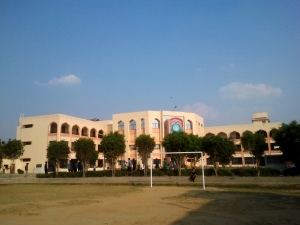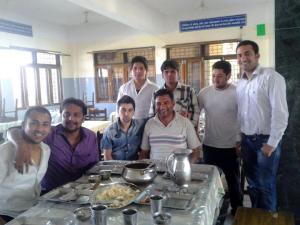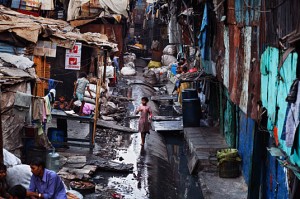NPT: Club of haves and have-nots
April 29, 2013 Leave a comment
The Treaty became an international law in 1970 and was extended indefinitely in 1995. Hitherto, a total of 190 countries have ratified the Treaty. Under the Treaty, the five countries formally recognized as nuclear weapon states (NWS) include China, France, Britain, United States and Russia. The only four countries not party to the Treaty are India, Israel, Pakistan and North Korea – all of them big nuclear powers.
The member states of NPT have been holding regular meeting to discuss their responsibilities and chalk out the strategies to promote the culture of non-proliferation and disarmament under the NPT. The Treaty is reviewed every five years in meetings called Review Conference. There is also a two-week Preparatory Committee (PrepCom) conference that meets once a year ahead of the Review Conference. In preparation for the Review Conference in 2015, there are three PrepComs: 2012 (Vienna), 2013 (Geneva), and 2014 (New York). This year, the meeting is taking place in Geneva and is attended by the representatives of all the member states of NPT. During the PrepComs, working papers are tabled and a final summary statement is drafted though the documents are not binding. They are to be used as assessment tools for five-yearly Review Conference, where a final consensus document is produced.
The Treaty was conceived with an objective to prevent nuclear proliferation, work towards full disarmament and promote the peaceful use of nuclear technology. The non-nuclear members states of NPT had agreed not to acquire nuclear weapons and the nuclear member states had pledged to promote the peaceful use of nuclear technology and take determined steps towards total nuclear disarmament. So, the big question is: has the NPT been a success or failure, and have the objectives and goals been met. I was discussing the same issue on Iranian news channel Sahar the other night and I categorically said the treaty has become a farce. It really has.
Under Article 1 of the Treaty, the five nuclear weapon states are not supposed to transfer the nuclear weapons to non-nuclear weapon state. But, we know how France helped Israel in building nuclear arsenal, China helped Pakistan become a nuclear power, US displayed its magnanimity towards India. Interestingly, all these beneficiaries are not the members of NPT. India refused to sign the treaty as it found it ‘faulty’ and a ‘club of nuclear haves and have-nots’. During a visit to Tokyo in 2007, India then External Affairs Minister Pranab Mukherjee said, “If India did not sign the NPT, it is not because of its lack of commitment for non-proliferation, but we consider NPT a flawed treaty.” Pakistan maintains that it will not sign as long as India does not. Pakistani Foreign Ministry spokesman, Abdul Basit, told a news agency few years back that Pakistan is willing to abandon its position on Nuclear Non-Proliferation Treaty (NPT) in case India joins it. He put the blame squarely on western powers for destabilizing the security situation in the region and increasing the dependence of Pakistan on nuclear weapons. Israel, like its important ally India, finds the Treaty ‘flawed and hypocritical’. “This resolution is deeply flawed and hypocritical. It ignores the realities of the Middle East and the real threats facing the region and the entire world,” said an Israeli government spokesman in response to a 28-page declaration by NPT in 2010 asking Israel to fall in line.
Article XI of the Treaty is interesting. It unequivocally calls for disarmament by the nuclear weapon states. “Each of the parties to the Treaty undertakes to pursue the negotiations in good faith on effective measures relating to cessation of the nuclear arms race at an early date and to nuclear disarmament,” reads the Article. The language, however, is vague and prone to misinterpretation. It does not make it mandatory for nuclear member states to disarm, but to do so in ‘good faith’, and without setting any time frame to do so. The powerful nuclear member states of NPT have used this vagueness to their advantage and refused to comply with it. Instead of moving towards total disarmament, they have willfully and vigorously carried on with their nuclear proliferation at a staggering level. According to NPT, these nuclear states cannot use their nuclear weapons against the non-nuclear state, but despite that, they have constantly threatened to use nuclear weapons against what they call ‘rogue states’. United States continuously targeted North Korea between 1959 and 1991, forcing it to quit NPT and develop nuclear weapons. Now, North Korea, like Iran, has become a ‘rogue state’ that needs to be annihilated.
Quite interestingly, ‘rogue states’ like Iran and North Korea, in their terminology, are different from the ‘pariah states’ like Myanmar and Zimbabwe. William Blum, author of ‘Rogue States: The Guide to the World’s Only Superpower’ has a fitting answer to that. “United States, because of its foreign policy, is itself the biggest rogue state.” There is a sea of difference between the rhetoric and reality when it comes to the policies of these nuclear weapon states like US. Their obligation and commitment under Article VI of NPT to work towards total disarmament has turned out to be hogwash. The five nuclear members of NPT together have more than 22,000 warheads. The commitments made at previous Review Conference in 2010 have not been fulfilled. The progress on the NPT Action Plan has been slow and uninspiring.
Among the four states not party to NPT, the case of India and Pakistan is curious. India first test fired in 1974 and Pakistan followed it up in 1998. India is believed to possess material for more than 150 warheads, while Pakistan has between 80 and 120 warheads. The two countries have gone to war on two occasions, and the likelihood of another war can never be ruled out considering the simmering tension. The logjam over Kashmir, the bone of contention, occasionally takes ugly turns to the extent that both the nuclear powers threaten each other. According to NPT, any nuclear deal between NPT member states and these four countries is illegal. Yet, United States went ahead with Indo-US nuclear deal in 2006, and China signed a civil nuclear deal with Pakistan in 2010, both in direct violation of the Treaty as it prohibits export of nuclear reactors to countries that have not signed the pact (in this case India and Pakistan).
Israel has the tendency to act like a stubborn child. It refuses to confirm or deny the possession of nuclear weapons, but the cat was out of the bag as early as 1986 when an Israeli technician Mordechai Vanunu published details of Israel’s nuclear program in Sunday Times UK. He was soon arrested and charged for treason. On September 18, 2009, International Atomic Energy Agency (IAEA) called on Israel to open its nuclear facilities for IAEA inspection and adhere with the resolution regarding non-proliferation, but it out-rightly refused to comply. The question is, why does Israel need to be the only nuclear-armed state in the Middle East? Why no outrage over the breach of International laws by Israel? Why the grotesque double standards while dealing with Israel?
Iran, on the other hand, continues to be in the center of storm. Thomas Countryman, assistant secretary of State for international security and nonproliferation, at the ongoing NPT Preparatory Committee meeting in Geneva said, “Possession of nuclear weapons by Iran constitutes a threat to the entire region and an impetus for greater proliferation, lateral proliferation of weapons”. Iran’s Foreign Ministry shot back saying that the country is “loyal” to its Nuclear Nonproliferation Treaty obligations. As a signatory of NPT, Iran claims its right under Article IV of the Treaty to pursue peaceful nuclear energy program.
Despite no credible evidence confirming the presence of nuclear weapons in Iran, the crippling economic sanctions against the country continue. Dr. Hans Blix, former Director General of IAEA believes there is no clear evidence to nail Iran.
“Iran has not violated NPT and there is no evidence right now that suggests Iran is producing nuclear weapons,” he said recently during an event in Dubai.
Unlike Israel, Iran has always welcomed IAEA inspectors to inspect its nuclear sites. The negotiations between Iran and West are stalled not because of Iran, but because of West’s obstructionism and sanction policy. Iran had proposed to stop the uranium enrichment at 20 per cent if it got 20 per cent enriched fuel in exchange from west. The offer was turned down, and was followed by sanctions.
For Iran, not producing nuclear weapons or weapons of mass destruction is a religious obligation, a fact attested by Ayatollah Khamenei’s fatwa (decree) against nuclear weapons. Iran realizes that a nuclear armed Iran will lead to a nuclear race in the region and that can have worrying repercussions. It also knows that it is likely to lose trusted friends like Russia and China and face isolation if it produces nuclear weapons.
Two high profile rounds of talks in Kazakhstan have already taken place this year without any noticeable gains. Addressing representatives of the Non-Aligned Movement (NAM) on the sidelines of the NPT Preparatory Committee meeting in Geneva, Iran’s deputy chief nuclear negotiator, Ali Baqeri said Tehran is ready to engage with Group 5+1 to work out a lasting settlement to all vexed issues. Referring to the recent meeting between Iran and the Group 5 1 in Almaty, Kazakhstan, he said the group has not fulfilled its promise yet. The EU foreign policy chief, Catherine Ashton, who represents the Group5+1 in talks with Iran, was supposed to inform Iran’s chief negotiator Saeed Jalili about the outcome of her consultations with the six countries, but she has failed to keep her word.
Meanwhile, speaking at the NPT meeting in Geneva, Ali Asghar Soltanieh, Iran’s ambassador to the U.N. nuclear watchdog agency, hinted at the possibility of Iran being west’s reliable partner in Middle East.
“Western countries are advised to change gear from confrontation to cooperation, the window of opportunity to enter into negotiation for long-term strategic cooperation with Iran, the most reliable, strong and stable partner in the region is still open.”
The war-mongering, brinkmanship, coercive sanctions, and the military confrontation is not going to work. Negotiations are the only way out, And the ball, now, is in West’s court.











Recent Comments